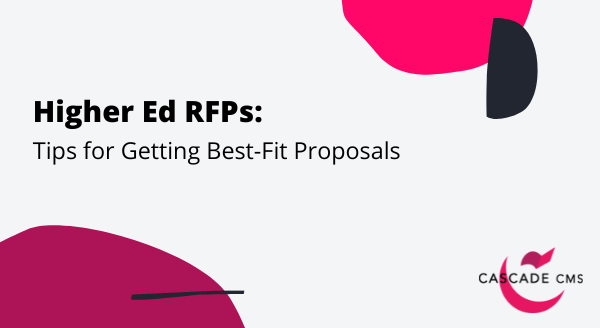
Most higher education organizations use Requests for Proposals (RFPs) to evaluate providers and procure products and services to help meet business objectives. And it can be a momentous occasion. In the case of RFPs for web content management systems or web projects like a redesign, an RFP means you’re getting closer to the reality of a new CMS or a better-functioning website.
Authoring an RFP is a serious undertaking, but it doesn't have to be a source of dread for Web and Marketing Teams. While it might be unrealistic to expect an organization to be excited to coordinate wish lists and write an RFP, there are ways to make the process smoother and increase the likelihood of high-quality responses from the best providers.
At Hannon Hill, we’ve reviewed and responded to hundreds of RFPs over our 21-year history. And they are not all created equal. The best RFPs are ones in which we understand why the organization is interested in replatorming, what they hope to do differently, how much they are willing to invest in the project, and when we feel confident we’ve deciphered formatting and submission instructions.
Here’s a list of tips we have for higher education institutions embarking on the RFP process for a new CMS or web project.
Limit Copy / Pasting From Previously-Authored Materials
We understand that authoring an RFP can be a laborious process - and one that's outside a committee’s traditional day jobs. To save time, teams will sometimes reuse large segments of content from old proposals or templates found online. While it’s certainly acceptable to reuse relevant questions, large-scale copy pasting leads to disorganization, redundancy, and contradictions.
Similarly, we recommend designating an RFP owner / editor to do a final proofread.
Attention to detail and thoughtful question-asking will help bidders be clear on your goals and feel confident that they are a good partner for the project.
Differentiate Must-Haves Versus Nice-to-Haves
Sometimes higher education organizations write RFPs that explain a perfect-fit product or service, knowing they might have to ultimately compromise in certain areas. When vendors understand which requirements are mandatory and which are nice-to-have, you’ll receive responses from providers who are better suited for the project.
Include Timeframe and Budget - Even if it’s a Ballpark
We understand that timelines and budgets are sensitive topics and sometimes held tightly to the chest. And it’s perfectly understandable. If I announce my budget in an RFP, all bidders are going to bid up to that max number, right?
For us and our partner network, that is not standard practice.
Our preference is to learn about budget and launch timeframe to structure our response in a way that satisfies as many requirements as possible, even if it means coming up with creative solutions. It also signals that financial conversations have been had, and that the organization is serious about the project.
If you don’t have a budget or timeline, consider releasing a simpler Request for Information (RFI) versus RFP.
And finally, it’s best to know as soon as possible if a provider’s products and services are cost prohibitive. There’s no sense in getting excited over a proposal only to review the financial proposal and learn that it’s outside of the institution’s budget.
Give Bidders Adequate Time to Submit Proposals
Similar to publishing project dates and milestones, be transparent about timelines for the RFP itself. Include all key dates, including when Q&A ends, when proposals are due (and how!), when they will be evaluated, and when respondents will be notified of a decision.
Leave adequate time between a Q&A addendum and due date, especially if multiple copies are due by mail.
Wrap Up
The purpose of this blog post is not to publish our wish list for how we’d like to see RFPs written. The purpose is to help higher education organizations get high-quality responses from vendors who can complete a project to specs.
Writing an RFP is an investment, and a big step towards a better future state. A little extra effort will go a long way towards soliciting strong responses and feeling confident that you’re choosing the right vendor.
If your organization has an RFP on the horizon, we are more than happy to share our knowledge in any way we can. Feel free to drop us a line at info@hannonhill.com.
Last Updated: Jun 23, 2022 11:00 AM